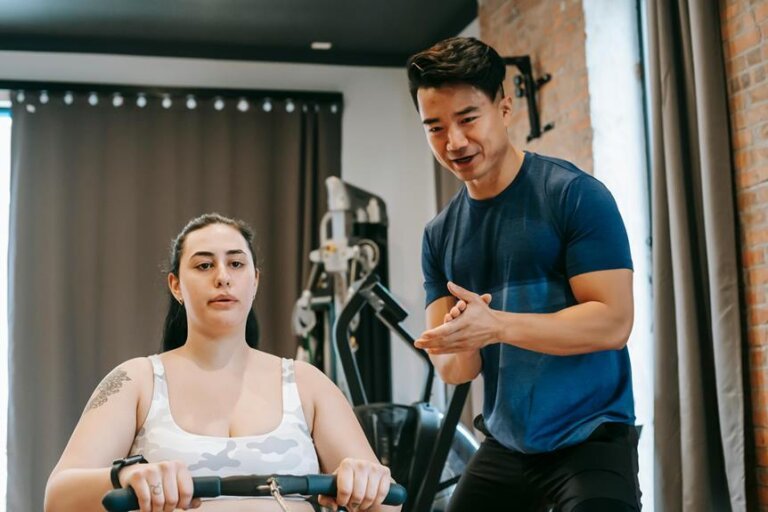The Importance of Strength Training for Older Individuals: A Comprehensive Guide
As you navigate the winding road of aging, consider strength training as your steadfast compass, guiding you towards a path of vitality and well-being.
The journey of incorporating strength training into your routine offers more than just physical gains; it holds the key to unlocking a world of benefits that can revolutionize your quality of life.
From enhancing bone density to reducing the risk of falls, the significance of strength training for older individuals is profound. But what exactly makes it so crucial, and how can you harness its power to enhance your golden years?
Benefits of Strength Training
Strength training can significantly improve muscle mass and bone density in older individuals. By engaging in regular strength training exercises, you can enhance your overall physical health and quality of life.
As you age, muscle mass tends to decrease, leading to reduced strength and mobility. However, with a consistent strength training routine, you can counteract this natural decline by building and maintaining muscle mass. This increased muscle mass not only improves your strength but also supports better posture and balance, reducing the risk of falls and injuries.
Moreover, strength training plays a crucial role in boosting bone density. As you put stress on your bones during resistance exercises, they adapt by becoming stronger and denser. This is particularly important for older adults as it can help prevent conditions like osteoporosis and reduce the risk of fractures. By incorporating strength training into your fitness regimen, you aren't only enhancing your physical capabilities but also investing in your long-term bone health.
Impact on Bone Density
Improving bone density through strength training is essential for maintaining overall skeletal health as you age. As you get older, your bones naturally lose density, becoming more fragile and prone to fractures. By engaging in regular strength training exercises, you can help combat this natural decline in bone density. When you perform strength training activities such as lifting weights or using resistance bands, the stress placed on your bones stimulates them to become stronger and denser over time.
Research has shown that strength training not only helps in increasing bone density but also plays a crucial role in reducing the risk of osteoporosis, a condition characterized by weak and brittle bones. By incorporating strength training into your routine, you're actively working towards preventing bone loss and maintaining the structural integrity of your skeletal system.
Therefore, making strength training a regular part of your fitness regimen can significantly impact your bone health, promoting longevity and independence as you age.
Enhancing Balance and Stability
Improve your balance and stability by focusing on core strength benefits. Engaging in functional movement exercises can enhance your ability to perform routine tasks with ease and confidence. Implementing fall prevention strategies is crucial for maintaining proper posture and stability in various activities.
Strengthening your core muscles will help you maintain proper posture and stability in various activities. Functional exercises mimic daily movements, enhancing your ability to perform routine tasks with ease and confidence.
Core Strength Benefits
Enhancing balance and stability through core strength training is essential for older individuals to maintain functional independence and reduce the risk of falls. By focusing on strengthening your core muscles, including the abdominals, obliques, and lower back, you can improve your overall balance and stability.
A strong core provides a solid foundation for your body, allowing you to move with more control and confidence in your daily activities. This increased stability can help prevent trips and slips that may lead to falls, ultimately reducing the risk of injury.
Incorporating core-focused exercises into your strength training routine, such as planks, bridges, and Russian twists, can significantly enhance your balance and stability as you age.
Functional Movement Exercises
To further enhance your balance and stability as an older individual, focus on incorporating functional movement exercises into your strength training routine. These exercises mimic everyday movements, helping you improve coordination and prevent falls.
Include exercises like single-leg stands, heel-to-toe walks, and squats to challenge your balance and build stability. Engaging in activities that require you to shift your weight and maintain control will train your body to react effectively in real-life situations.
Fall Prevention Strategies
Incorporate targeted exercises into your routine to boost balance and stability and reduce the risk of falls as you age. Focus on exercises that enhance core strength, such as planks and abdominal twists, to improve your body's ability to maintain equilibrium.
Additionally, practice single-leg stands or heel-to-toe walking to challenge your balance and build stability. Engage in activities like tai chi or yoga to enhance coordination and promote flexibility, crucial components for preventing falls.
Ensure your workout routine includes exercises that target leg muscles like squats and lunges, as strong legs are fundamental for supporting your body and preventing trips or stumbles. By consistently incorporating these balance-enhancing exercises, you can fortify your stability and reduce the likelihood of falls as you grow older.
Improving Daily Functionality
Improving your daily functionality through strength training can significantly enhance your overall quality of life as you age. Strength training helps you maintain muscle mass and bone density, making everyday tasks easier to perform. By increasing your strength, you can improve your ability to carry groceries, climb stairs, or even get up from a chair without assistance. This independence fosters a sense of self-reliance and boosts your confidence in handling daily activities.
Furthermore, strength training can enhance your balance and coordination, reducing the risk of falls and injuries. As you age, these factors become increasingly important for maintaining a high level of functionality. With improved strength and stability, you can move more efficiently and with greater ease, whether you're navigating crowded spaces or engaging in recreational activities.
Incorporating strength training into your routine also supports cognitive function by stimulating brain activity and promoting mental acuity. This can help you stay sharp and focused as you go about your daily tasks, contributing to an overall sense of well-being and vitality.
Reducing Risk of Falls
To reduce your risk of falls, focus on fall prevention strategies, work on improving your balance and stability, and understand the importance of muscle strength.
By incorporating these aspects into your strength training routine, you can enhance your overall stability and reduce the likelihood of experiencing a fall.
Fall Prevention Strategies
To decrease the chances of falls, older individuals should focus on strengthening their lower body muscles through targeted exercises. Engaging in activities like squats, lunges, leg presses, and calf raises can help improve balance and stability, reducing the risk of falls.
Additionally, incorporating resistance training using resistance bands or weights can further enhance muscle strength and coordination. It's essential to gradually increase the intensity of these exercises to continually challenge your muscles and promote growth.
Alongside strength training, ensuring your living environment is free of hazards, such as loose rugs or slippery floors, can significantly reduce the risk of falls. By prioritizing lower body strength and maintaining a safe environment, you can proactively work towards preventing falls and maintaining your independence.
Balance and Stability
To enhance your balance and stability, focus on exercises that target key muscle groups and promote coordination, lowering the risk of falls. Incorporate exercises like single-leg stands, heel-to-toe walks, and hip abductions to challenge your balance and improve stability.
These exercises help strengthen the muscles in your legs, core, and hips, which are essential for maintaining equilibrium and preventing falls. Additionally, practicing yoga or tai chi can also enhance your balance, flexibility, and overall stability.
Consistent training in these areas won't only reduce your risk of falls but also improve your confidence in daily activities. Remember, balance and stability are crucial for maintaining independence and quality of life as you age.
Muscle Strength Importance
Improving muscle strength is essential for reducing the risk of falls in older individuals. As you age, muscle mass naturally decreases, leading to weaker muscles that struggle to support your body. This decline in strength can affect your ability to maintain balance and stability, increasing the likelihood of falls.
By engaging in regular strength training exercises, such as squats, lunges, and resistance training, you can effectively strengthen your muscles, improve coordination, and enhance your overall stability. Strong muscles provide better support for your joints and bones, helping you move with confidence and reduce the risk of falls.
Prioritizing muscle strength through targeted exercises is a proactive approach to maintaining your independence and staying safe as you age.
Principles of Effective Training
Effective strength training for older individuals requires a structured and progressive approach to ensure safe and beneficial outcomes. When designing a strength training program, it's essential to consider key principles that can help you maximize the benefits while minimizing the risks.
Firstly, focus on proper form and technique to prevent injuries and target the intended muscle groups effectively. This means starting with lighter weights to master the movements before gradually increasing the load.
Secondly, ensure consistency in your training routine to see improvements in muscle strength and endurance over time. Consistent training also helps maintain the gains achieved and prevents muscle loss that can occur with age.
Thirdly, progressively overload your muscles by gradually increasing the intensity, volume, or frequency of your workouts. This gradual progression challenges your muscles to adapt and grow stronger.
Lastly, listen to your body and adjust your training program as needed to accommodate any physical limitations or changes in health. By following these principles, you can create an effective strength training regimen that supports your overall health and well-being.
Key Considerations for Seniors
Considering the unique needs and abilities of older individuals, it's crucial to tailor strength training programs to ensure safety and effectiveness. Before starting any strength training regimen, consult with a healthcare provider to assess your current fitness level and discuss any underlying health conditions.
It's important to choose exercises that target multiple muscle groups and focus on improving balance, flexibility, and coordination. Start with light weights or resistance bands and gradually increase the intensity as your strength improves. Incorporating proper warm-up and cool-down routines is essential to prevent injuries and reduce muscle soreness.
Additionally, pay attention to your body's signals during exercise. If you experience pain, dizziness, or shortness of breath, stop immediately and seek medical advice. Hydration is key, so remember to drink plenty of water before, during, and after your workout. Adequate rest between workouts is crucial for muscle recovery and growth.
Practical Tips for Getting Started
To kickstart your strength training journey as an older individual, focus on implementing practical tips that will help you get started on the right track. Begin by consulting with your healthcare provider to ensure that you're cleared for physical activity and to discuss any specific concerns or limitations you may have.
Once you have the green light, start slowly and gradually increase the intensity of your workouts to prevent injury and allow your body to adapt. Consider working with a certified personal trainer, especially one experienced in training older adults, to help you develop a safe and effective exercise routine tailored to your needs and goals.
Remember to prioritize proper form over heavy weights to reduce the risk of strains or sprains. Additionally, don't forget the importance of incorporating rest days into your routine to allow your muscles to recover and grow stronger.
Stay consistent, stay motivated, and celebrate your progress along the way!
Frequently Asked Questions
Can Strength Training Help With Joint Pain and Arthritis in Older Individuals?
Strength training can indeed help with joint pain and arthritis in older individuals. By strengthening muscles around the joints, you can improve stability, reduce pain, and maintain function. Regular exercise tailored to your needs is key.
Is It Necessary to Use Heavy Weights for Strength Training, or Are Bodyweight Exercises Sufficient for Older Adults?
You don't necessarily need heavy weights for strength training. Bodyweight exercises can be sufficient for older adults. Focus on proper form and progression. Consult a fitness professional to tailor a program that suits your needs and abilities.
Are There Any Specific Dietary Recommendations or Supplements That Can Enhance the Benefits of Strength Training for Seniors?
To enhance strength training benefits, consider a balanced diet rich in protein, vitamins, and minerals. Consult a healthcare provider for personalized recommendations on supplements. Remember, proper nutrition can optimize your workouts and help you achieve your fitness goals.
How Often Should Older Individuals Engage in Strength Training to See Noticeable Improvements in Muscle Mass and Strength?
Feeling like a couch potato? Well, get ready to flex those muscles regularly! Engage in strength training at least 2-3 times a week to witness impressive gains in muscle mass and strength as you age gracefully.
Are There Any Potential Risks or Precautions That Older Individuals Should Be Aware of Before Starting a Strength Training Program?
Before starting a strength training program, ensure to consult with a healthcare provider. Potential risks for older individuals include injury from improper form or too much weight. Start slowly, focus on technique, and listen to your body.
Conclusion
In conclusion, strength training is a crucial component for older individuals to maintain their independence and quality of life. By incorporating regular strength training exercises into your routine, you can strengthen your bones, improve balance, and reduce the risk of falls.
Remember, it's never too late to start – so don't let the grass grow under your feet. Start lifting weights and feel the difference in your strength and overall well-being!





